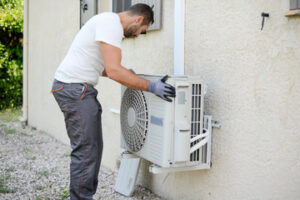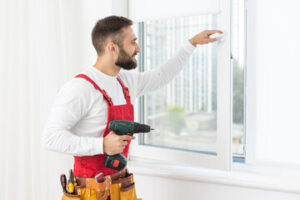Whether you’re a homeowner or business owner, choosing the right HVAC system requires careful thought and consideration. Several factors influence your decision, from climate and home size to energy efficiency and costs.

Designed for comfort and efficiency, these systems use zoning to heat or cool only the rooms you’re using, preventing energy waste in unoccupied spaces. They also offer filtration to remove viruses, dust and pollutants from your indoor air. Contact HVAC Round Rock for professional help.
Heating systems are one of the most significant consumers of energy in homes and commercial buildings. They use energy to keep air warm and remove pollutants, dust and other harmful particles from indoor spaces. HVAC systems also provide ventilation to keep the air fresh and clean.
The main components of a typical heating system include an air return, filter and furnace. The air return sucks in air from the space and passes it through the filter, which is designed to capture pollutants before they can pass into the main system. The furnace then uses fuel to heat the air, which is then pushed into the room via ductwork.
Depending on the type of heating system, it may use oil, gas or electricity as fuel. This system is a great choice for those who are looking to cut back on their energy consumption and reduce environmental impact.
A portable spot cooler, for example, uses a heat pump to cool spaces. It draws in outdoor air, cools it with a closed-loop refrigerant coil and reroutes the air to indoor spaces through ductwork. It is a more efficient alternative to air conditioning units that rely on electric resistance heaters.
The energy efficiency of HVAC systems is crucial to their ability to minimize environmental impacts. Purchasing energy-efficient models with high Seasonal Energy Efficiency Ratings (SEER) or Annual Fuel Utilization Efficiency (AFUE) ratings can reduce the amount of electricity and fossil fuels used and lower demand on power plants.
Many HVAC systems rely on natural gas or liquid refrigerants to operate, which can be problematic for the environment. Although they are less damaging than the chlorofluorocarbons and hydrochlorofluorocarbons used in older HVAC systems, these chemicals still release greenhouse gases into the atmosphere. This can lead to climate change, which is why it’s important for the industry to transition to alternative refrigerants that have low or negligible global warming potential.
Other environmental concerns associated with HVAC systems include water usage and waste production. The extraction of natural resources for the production of refrigerants can deplete the world’s supply, and improper disposal of waste can lead to water pollution. Fortunately, the industry can address these concerns by switching to more eco-friendly systems and implementing water management strategies that reduce waste and promote environmental sustainability.
Ventilation
Ventilation is an essential part of a HVAC system that ensures that your indoor air remains clean and properly circulated. It works to reduce humidity, normalize temperatures and remove irritants such as dust and pollutants. Ventilation systems rely on ductwork to distribute conditioned air throughout your building, as well as fans and air filters to improve indoor air quality.
Ventilating your building helps reduce contaminants and irritants such as pet dander, dust and pollen. These allergens can contribute to asthma and other respiratory conditions. In addition, high moisture levels in a building create an ideal environment for mold and bacteria to thrive.
Your ventilation system typically uses ducts, return vents and blowers to provide mechanical ventilation that can remove these pollutants from your indoor air. Ventilation systems also help maintain the recommended air exchange rate, which varies depending on the type of building and occupants.
During heating, your HVAC unit uses a furnace to generate warmth that is distributed throughout your home through the ductwork. Similarly, during cooling, an air conditioner uses refrigerant to cool your home by absorbing heat from the indoor air that passes over the coils. Your cooling system then blows the cool air back into your house through the evaporator coils.
The air return is an important part of your ventilation system because it marks the starting point for the entire system. The return sucks air into the ductwork, passing it through a filter and into the rest of the system. It’s important to check your filters regularly and keep them clean to avoid problems like poor airflow, increased energy usage and reduced comfort levels.
A commercial HVAC system will also need a chimney flue or ventilation stack to expel the exhaust produced by your furnace or air conditioner. It’s best to check these outlets at least once a year for leaks or debris.
For large buildings, a commercial ventilation system may use an ERV or energy recovery ventilator (ERV) to preheat or cool outdoor air before it enters the building. This can significantly cut down on energy costs. However, these systems can be expensive to install and operate.
Compressors
The compressor is the heart of your AC system. It’s responsible for converting high-pressure gas into low-pressure refrigerant that will vaporize when it cools down, providing the cooling power your home needs. Unlike pumps, which increase the density of liquids, compressors focus on changing volume in gases.
There are many different types of air compressors, each with its own set of advantages and disadvantages. Some are more difficult to maintain, while others have higher initial costs but lower operating and energy consumption over time. You should always choose an air compressor that meets the requirements of your environment and is designed to work efficiently in it.
The most common type of air compressor is the rotary screw. This compressor uses two meshed rotating positive-displacement helical screws to force air into a smaller space, which compresses the air and raises its temperature. They come in various sizes and pressure ratings and are used for industrial, commercial, and portable applications.
Another popular air compressor is the reciprocating compressor, which is driven by a piston that moves up and down in a circular motion inside a cylinder. Its components include an inlet valve, outlet valve, and piston. Its motor is powered by an electric or internal combustion engine and drives a shaft that causes the piston to move up and down in order to create a vacuum effect, which compresses the air.
Other types of compressors include the screw, centrifugal, and diaphragm. Diaphragms are often able to handle high degrees of flexing but require frequent replacement as plastic embrittlement occurs. The hermetic compressor has a sealed housing and is more efficient, but it cannot be opened for maintenance. The semi-hermetic compressor strikes a balance between hermetic and open, combining the benefits of each while being easy to service.
Green compressors are essential in hospitals and other healthcare settings to power medical equipment, provide oxygen, and deliver clean air. They also play a major role in food and beverage production, where they provide a pure oil-free air supply for processing and bottling products. Other industries that rely on eco-conscious compressors to reduce their carbon footprint and meet sustainability goals include aviation, marine, manufacturing, mining, agriculture, and oil and gas.
Filters
Air filters are the last line of defense for a home’s HVAC system, keeping larger particles from clogging the machinery that heats and cools. They also prevent the spread of pollutants, such as dirt, dust, pet dander and mold spores. Regular filter replacement and maintenance are vital to the efficiency of any system. If a filter isn’t replaced or cleaned regularly, it will become clogged with debris and the system will work harder to keep a home warm or cool.
Filters can be purchased in many sizes, but the real question is what type of filter is best for a particular system. A standard fiberglass disposable filter is a basic option that’s economical and fairly effective. These filters are a mix of layers of fiberglass material, with a metal grate to reinforce them. They have a low MERV rating, typically 1 to 4, which provides minimal contaminant protection and does little to improve indoor air quality.
Reusable electrostatic filters are more expensive than disposable filters, but they perform better for contaminant removal and indoor air quality improvement. These filters consist of flat metal plates that are charged with static electricity, which attracts dirt and other particles to the surface. They have a higher MERV rating, often 5 to 13, and they are more efficient than disposable or basic pleated filters.
Bag filters are a more efficient option than other types of filters because they have a large surface area that helps them remove a greater number of contaminants. They’re available in a variety of MERV ratings and are the most cost-effective option for highly sanitized spaces, such as hospitals and surgery centers.
Be sure to replace the filter every 30 days if your system is in heavy use, and even sooner during pollen season or in homes with pets. If you don’t replace or clean your filters regularly, they can overwork the system and cause a pressure drop that will interfere with optimum performance. Changing or cleaning a filter may take just a few minutes if the system is properly equipped with a quick-release filter. Make sure you’re buying the correct size by checking the actual measurements on your existing filter or referring to the system’s owner’s manual for details.
